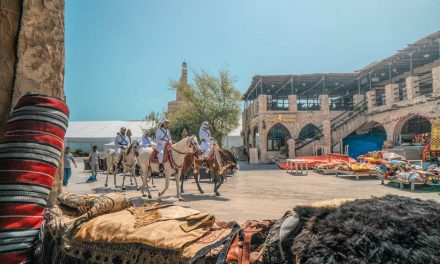Table of Contents
“Arab Calligraphy: Unleashing the Power of Leadership through Timeless Artistry”
Introduction
Arab Calligraphy: Writing the Future of Leadership
Arab calligraphy is an ancient art form that holds deep cultural and historical significance in the Arab world. It is a unique form of writing that combines intricate designs and skilled craftsmanship to create visually stunning pieces of art. In recent years, Arab calligraphy has gained recognition not only for its aesthetic appeal but also for its potential to inspire and shape future leaders. This introduction explores the role of Arab calligraphy in writing the future of leadership, highlighting its ability to convey powerful messages, foster creativity, and promote cultural understanding.
The History and Evolution of Arab Calligraphy

Arab Calligraphy: Writing the Future of Leadership
Arab calligraphy is a rich and ancient art form that has played a significant role in shaping the cultural and artistic landscape of the Arab world. With its roots dating back to the 7th century, it has evolved over time, reflecting the changing political, social, and religious dynamics of the region. This article explores the history and evolution of Arab calligraphy, highlighting its importance in the development of leadership and its potential to shape the future.
The origins of Arab calligraphy can be traced back to the time of the Prophet Muhammad, who emphasized the importance of the written word in Islamic culture. The Quran, the holy book of Islam, was revealed to the Prophet Muhammad through divine inspiration, and its verses were meticulously transcribed by scribes. This led to the development of a unique script known as Kufic, characterized by its angular and geometric forms.
Over the centuries, Arab calligraphy underwent various transformations, influenced by different artistic and cultural movements. During the Abbasid period (750-1258), calligraphers began to experiment with new styles, introducing more fluid and cursive scripts such as Naskh and Thuluth. These scripts allowed for greater expressiveness and artistic freedom, enabling calligraphers to create intricate and visually stunning compositions.
Arab calligraphy reached its zenith during the Ottoman Empire (1299-1922), where it became an integral part of the courtly culture. The Ottoman sultans, known for their patronage of the arts, commissioned calligraphers to create elaborate manuscripts and inscriptions for mosques and palaces. This period witnessed the emergence of the Sulus script, characterized by its elegant and flowing lines, which became the standard script for official documents.
In addition to its aesthetic appeal, Arab calligraphy has always been imbued with deeper meanings and symbolism. Each letter and stroke carries spiritual significance, and calligraphers strive to convey the beauty and power of the written word. The art of calligraphy is not merely about writing; it is a spiritual practice that requires discipline, patience, and a deep understanding of the Arabic language.
Today, Arab calligraphy continues to thrive, with contemporary calligraphers pushing the boundaries of the art form. They draw inspiration from traditional scripts while incorporating modern elements and techniques. This fusion of old and new has given rise to innovative styles and approaches, reflecting the dynamism and diversity of the Arab world.
Moreover, Arab calligraphy has transcended its traditional role as a decorative art form and has found its way into various aspects of contemporary life. It is now used in advertising, branding, and graphic design, serving as a powerful tool for communication and self-expression. Its ability to convey complex ideas and emotions through visual forms makes it an ideal medium for leadership and advocacy.
In conclusion, Arab calligraphy is a testament to the rich cultural heritage of the Arab world. Its history and evolution reflect the changing dynamics of the region, while its aesthetic beauty and spiritual significance continue to captivate audiences worldwide. As we look to the future, Arab calligraphy has the potential to shape the world of leadership, offering a unique and powerful means of communication and expression. By embracing this ancient art form, leaders can tap into its transformative power and inspire others to follow in their footsteps. Arab calligraphy truly has the ability to write the future of leadership.
The Role of Arab Calligraphy in Contemporary Leadership
Arab Calligraphy: Writing the Future of Leadership
The art of calligraphy has a long and rich history in the Arab world. It is not just a form of writing, but a true art form that has been passed down through generations. In recent years, there has been a growing recognition of the role that Arab calligraphy can play in contemporary leadership. This article will explore the significance of Arab calligraphy in shaping the future of leadership.
One of the key aspects of Arab calligraphy is its aesthetic beauty. The intricate and elaborate designs of Arabic letters are not only visually appealing but also convey a sense of elegance and sophistication. This attention to detail and craftsmanship is a reflection of the qualities that are valued in a leader – someone who pays attention to the finer details and strives for excellence.
Moreover, Arab calligraphy is deeply rooted in Islamic culture and spirituality. The Arabic script is closely associated with the Quran, the holy book of Islam. As such, calligraphy is seen as a sacred art form that carries a spiritual significance. This connection to spirituality can be seen as a valuable asset for leaders, as it can provide them with a sense of purpose and guidance in their decision-making.
In addition to its aesthetic and spiritual qualities, Arab calligraphy also embodies a sense of tradition and heritage. The art form has been practiced for centuries and has become an integral part of Arab culture. By embracing calligraphy, leaders can demonstrate their respect for tradition and their commitment to preserving cultural heritage. This can help to foster a sense of identity and pride among their followers, which is essential for effective leadership.
Furthermore, Arab calligraphy is a form of self-expression. Each calligrapher brings their own unique style and interpretation to their work. This individuality and creativity can be seen as a valuable trait for leaders, as it allows them to think outside the box and approach challenges from a fresh perspective. By encouraging creativity and self-expression, leaders can inspire innovation and foster a culture of continuous improvement within their organizations.
Another important aspect of Arab calligraphy is its ability to communicate meaning and emotion. The Arabic script is known for its expressive nature, with each stroke and curve conveying a specific message. This ability to communicate effectively is a crucial skill for leaders, as they need to be able to articulate their vision and inspire others to follow them. By studying calligraphy, leaders can learn the art of effective communication and develop their own unique voice.
In conclusion, Arab calligraphy has a significant role to play in contemporary leadership. Its aesthetic beauty, spiritual significance, connection to tradition, and ability to communicate meaning and emotion all make it a valuable asset for leaders. By embracing calligraphy, leaders can demonstrate their attention to detail, their commitment to tradition, and their ability to communicate effectively. In doing so, they can shape the future of leadership and inspire others to follow in their footsteps. Arab calligraphy is not just a form of writing; it is a powerful tool that can help leaders leave their mark on the world.
Exploring the Cultural Significance of Arab Calligraphy in Leadership
Arab Calligraphy: Writing the Future of Leadership
Arab calligraphy is an art form that has deep cultural significance in the Arab world. It is not just a form of writing, but a way to express the beauty and complexity of the Arabic language. In recent years, Arab calligraphy has also been recognized for its potential to shape the future of leadership.
One of the reasons why Arab calligraphy is so important in leadership is its connection to tradition and heritage. The art form has been passed down through generations, with calligraphers honing their skills and techniques over time. This connection to the past gives Arab calligraphy a sense of authenticity and authority, which can be valuable in leadership roles.
Furthermore, Arab calligraphy is a visual representation of the Arabic language. The intricate and elegant designs of the calligraphy reflect the richness and depth of the language itself. This visual representation can be a powerful tool for leaders, as it allows them to communicate their ideas and values in a unique and impactful way.
In addition to its visual appeal, Arab calligraphy also has a spiritual dimension. The art form is often associated with Islamic culture and is used to write verses from the Quran. This spiritual connection can bring a sense of purpose and meaning to leadership, as it reminds leaders of their responsibility to serve and guide others.
Moreover, Arab calligraphy requires patience, discipline, and attention to detail. These qualities are essential for effective leadership. Leaders must be able to focus on the task at hand, pay attention to the needs of their followers, and make decisions with care and precision. Arab calligraphy can help cultivate these qualities in leaders, as it demands a high level of concentration and precision.
Furthermore, Arab calligraphy is a form of self-expression. Calligraphers often develop their own unique style and technique, which allows them to convey their individuality and personality through their work. This self-expression can be empowering for leaders, as it encourages them to embrace their own unique strengths and perspectives.
Arab calligraphy also fosters a sense of community and collaboration. Calligraphers often come together to share their knowledge and skills, and to learn from one another. This sense of community can be valuable for leaders, as it encourages them to build strong relationships and work collaboratively with others.
In conclusion, Arab calligraphy is a powerful tool for shaping the future of leadership. Its connection to tradition and heritage, visual appeal, spiritual dimension, and emphasis on patience and attention to detail all contribute to its significance in leadership roles. Furthermore, Arab calligraphy encourages self-expression and fosters a sense of community and collaboration. As leaders navigate an increasingly complex and diverse world, the art of Arab calligraphy can provide them with the skills, values, and perspectives needed to lead with authenticity and impact. By embracing the beauty and complexity of Arab calligraphy, leaders can write a future that is both meaningful and transformative.
The Impact of Arab Calligraphy on Visual Communication in Leadership
Arab Calligraphy: Writing the Future of Leadership
The art of calligraphy has long been revered in Arab culture, with its intricate designs and flowing lines capturing the beauty of the written word. But beyond its aesthetic appeal, Arab calligraphy has also had a profound impact on visual communication in leadership. From ancient times to the present day, this art form has played a crucial role in shaping the way leaders communicate their messages to the world.
One of the key ways in which Arab calligraphy has influenced leadership is through its ability to convey a sense of authority and power. The bold, sweeping strokes of calligraphic scripts such as Thuluth and Naskh exude confidence and command attention. When leaders incorporate these scripts into their visual communication, whether through logos, signage, or official documents, they are able to project a strong and authoritative image.
Moreover, Arab calligraphy has the unique ability to convey both tradition and innovation simultaneously. While calligraphy has a rich history dating back centuries, it has also evolved and adapted to the modern world. This duality is particularly relevant in the context of leadership, where leaders must balance the need to honor tradition with the necessity of embracing change. By incorporating calligraphy into their visual communication, leaders can strike this delicate balance, signaling their respect for tradition while also demonstrating their forward-thinking approach.
In addition to its visual impact, Arab calligraphy also carries deep cultural and religious significance. The Arabic language, with its rich vocabulary and poetic traditions, is considered sacred by many. Calligraphy, as the art of writing Arabic, is therefore imbued with a sense of spirituality and reverence. When leaders incorporate calligraphy into their visual communication, they tap into this cultural and religious symbolism, connecting with their audience on a deeper level.
Furthermore, Arab calligraphy has the power to transcend language barriers. The beauty of calligraphy lies in its ability to communicate meaning through form and design, rather than relying solely on the written word. This makes it a powerful tool for leaders who operate in multicultural and multilingual contexts. By incorporating calligraphy into their visual communication, leaders can convey their messages in a way that is universally understood, fostering a sense of unity and inclusivity.
The impact of Arab calligraphy on visual communication in leadership extends beyond its aesthetic and cultural significance. It also has practical implications for effective communication. The intricate nature of calligraphic scripts requires precision and attention to detail. When leaders incorporate calligraphy into their visual communication, they are signaling their commitment to excellence and meticulousness. This attention to detail can inspire confidence in their leadership and enhance their credibility.
In conclusion, Arab calligraphy has had a profound impact on visual communication in leadership. Its ability to convey authority, balance tradition and innovation, carry cultural and religious significance, transcend language barriers, and enhance effective communication make it a powerful tool for leaders. As the world becomes increasingly interconnected, leaders who embrace the art of calligraphy will be better equipped to navigate the complexities of the future and write a new chapter in the history of leadership.
Q&A
1. What is “Arab Calligraphy: Writing the Future of Leadership”?
“Arab Calligraphy: Writing the Future of Leadership” is an art exhibition showcasing the significance of calligraphy in Arab culture and its role in shaping leadership.
2. What is the purpose of the exhibition?
The purpose of the exhibition is to highlight the artistic and cultural importance of Arab calligraphy and its connection to leadership, emphasizing its role in shaping the future.
3. Who is the target audience for the exhibition?
The exhibition is aimed at individuals interested in Arab culture, art enthusiasts, and those interested in exploring the relationship between calligraphy and leadership.
4. Where can one find the exhibition?
The specific location of the exhibition may vary, but it can typically be found in art galleries, cultural centers, or museums that host art exhibitions.
Conclusion
In conclusion, Arab Calligraphy is a powerful art form that holds great significance in the Arab world. It not only preserves the rich cultural heritage but also serves as a means of communication and expression. Through its intricate designs and deep symbolism, Arab Calligraphy has the potential to shape the future of leadership by promoting cultural understanding, fostering creativity, and inspiring individuals to embrace their heritage. As a timeless art form, it continues to captivate and inspire people around the world, making it an essential element in shaping the future of leadership in the Arab world and beyond.





Recent Comments